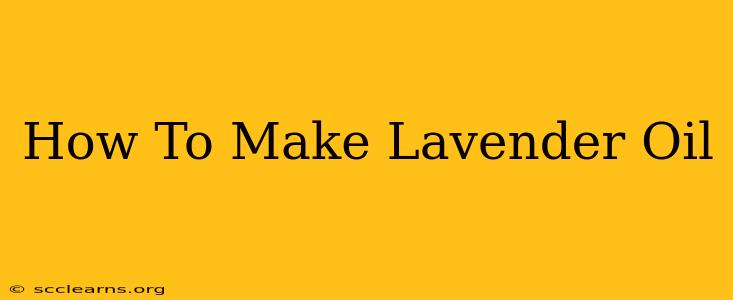Lavender oil, known for its calming aroma and therapeutic benefits, is prized worldwide. But did you know you can make your own? This comprehensive guide will walk you through the process of creating your own pure lavender oil, from harvesting to bottling. Let's get started!
Harvesting Lavender for Oil Production
The success of your lavender oil hinges on properly harvesting your lavender. Timing is key!
Optimal Harvesting Time:
The best time to harvest lavender for oil production is when the lavender flowers are in full bloom, typically during the peak of summer. This is when the essential oil content is at its highest. Look for vibrant purple buds with minimal green showing.
Harvesting Techniques:
- Cutting: Use sharp shears or scissors to cut the flowering stems, leaving about 4-6 inches of stem at the base. This encourages regrowth.
- Timing: Harvest in the morning after the dew has dried to avoid diluting the oil with water.
- Handling: Handle the harvested lavender gently to prevent bruising, which can affect the oil's quality.
Methods for Making Lavender Essential Oil
There are two primary methods for extracting lavender essential oil: steam distillation and solvent extraction. Steam distillation is the most common and produces a superior quality oil.
Steam Distillation: The Preferred Method
This method involves using steam to separate the essential oil from the plant material. It's a more time-consuming process, but yields a pure and potent oil.
What you'll need:
- Still: A steam distillation apparatus specifically designed for essential oil extraction. (You can purchase these online or at specialty stores.)
- Water: Plenty of clean, filtered water.
- Harvesting Lavender: Freshly harvested lavender flowers and stems.
- Collecting Vials: Sterile glass containers for collecting your precious lavender oil.
Step-by-Step Process:
- Preparation: Fill the still's boiler with water and carefully pack the lavender into the distillation chamber. Do not overpack.
- Distillation: Heat the water in the boiler to create steam. The steam passes through the lavender, carrying the essential oil with it.
- Condensation: The steam then passes through a condenser, cooling and condensing back into liquid form, with the essential oil separating from the water.
- Separation: The mixture of oil and water (called hydrosol) collects in a separate container. The essential oil, being less dense, will float on top and can be carefully separated.
- Drying: The oil should then be carefully dried using a desiccant, such as anhydrous sodium sulfate. This removes any trace amounts of water.
Solvent Extraction: A Less Common Approach
Solvent extraction uses a solvent (like hexane) to extract the oil. This method is less common for home production due to the use of potentially harmful solvents and the need for specialized equipment. It’s usually best left to commercial producers.
Bottling and Storing Your Lavender Oil
Once you have extracted your precious lavender oil, proper bottling and storage are crucial for maintaining its quality and potency.
Bottling:
Use dark-colored glass bottles to protect the oil from light, which can degrade its quality. Amber or cobalt blue bottles are ideal.
Storage:
Store your lavender oil in a cool, dark, and dry place. Avoid extreme temperatures. Properly stored, lavender oil can last for several years.
Using Your Homemade Lavender Oil
Now that you've successfully made your own lavender oil, you can enjoy its numerous benefits.
- Aromatherapy: Add a few drops to a diffuser for a calming and relaxing atmosphere.
- Topical Application: Dilute the oil with a carrier oil (like jojoba or almond oil) before applying it to your skin.
- DIY Cosmetics: Incorporate it into homemade lotions, creams, or soaps.
Making your own lavender oil is a rewarding experience. It allows you to connect with nature, create a valuable product, and enjoy the therapeutic benefits of pure, high-quality lavender essential oil. Remember to always prioritize safety and follow instructions carefully.

